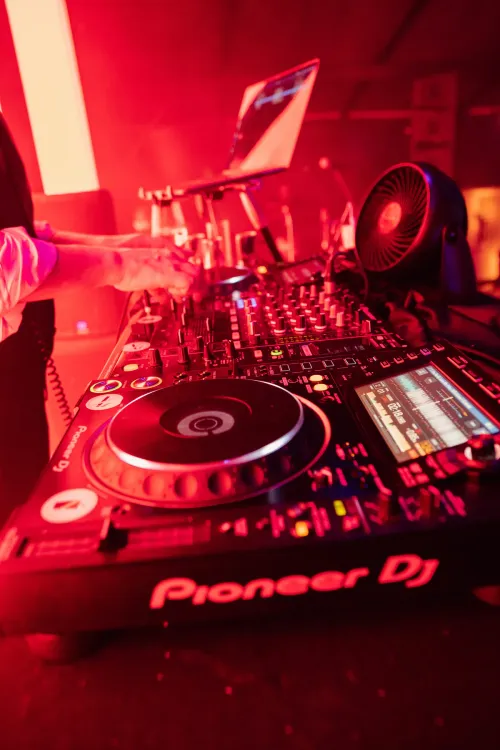I covered the basics of turntable anatomy in a previous post, so let's now get into the specific components. The tonearm is one of the most vital parts of your turntable - it's one of two moving parts (the other being the platter), excluding interface buttons and sliders. So, what does it do?
The tonearm holds the headshell (which contains the cartridge and stylus) and follows the groove in the record as it spins. The tonearm is responsible for keeping the stylus in the right place to produce high-fidelity sound for the duration of the record's playtime.
As the record spins, the needle starts close to the outer edge of the record and follows it in a tight spiral towards the centre label. A 7-inch record at 45rpm can hold up to 5 minutes and 30 seconds of music per side, and a 12-inch record at 33rpm can play for as long as 25 minutes, but generally, both will come in a little short of these maximums.
Based on this, the tonearm needs to be designed to move from the outer edge of the record to its centre slowly, keeping the stylus balanced within the record's groove no matter which point of the groove it's in. This sounds simple, but it can be complex. The rotation of the record naturally causes the arm to want to pull towards the record's centre, which can cause the needle to ride the inside edge of the groove and affect sound, or even cause skating (where the needle skips ahead to another point in the song or album) if it's not factored into the tonearm's design. Similarly, the arm's weight needs to be balanced to prevent the stylus from digging into the track too heavily, increasing wear over time and potentially leading to distortion.
For DJs, the tonearm of a good turntable will also provide options for adjustment. Generally, most sound-capturing hardware can be completely swapped out to match your preferences and playing style, which will impact weight and balance. Performing scratch DJs, for example, will want different hardware than more traditional DJs to get the most out of their turntables. You want to have options to adjust things quickly, especially if you often play with others, or something as simple as swapping a cartridge could be a much more difficult job.
For most people, the specific needs of a turntable and its headshell, cartridge and stylus will change over time as skills develop, so I'd strongly advise making sure you have the option of making adjustments to the balance of your tonearm should you choose a heavier or lighter cartridge, or a differently shaped headshell altogether, in the future.
With this covered, let's move on to the types of tonearm you'll come across and the reasons for these design choices.
1. Grouped by Tracking Trajectory:
- Straight Tonearm (Tangent Tracking): Imagine a ruler tracing the record groove perfectly. This is the ideal scenario for a tonearm, reducing tracking errors. However, a straight arm requires complex mechanisms. These are rare in the wild. You can find straight-arm models with complex antiskid mechanisms and balancing, but these tend to be tailored to the audiophile crowd rather than DJs and have a price point to match. Most DJ-centric straight-arm models I've used tend to be on the cheaper end of the spectrum and have the sound quality to match, though this isn't a hard and fast rule. Related to, but not technically in this category, are tonearms with an offset headshell, angling the cartridge to achieve similar tracking without complex mechanisms.
- Curved Tonearm (Crankarm Tracking): These are more common, usually referred to as S or J based on the curvature (you may also see 'I' used to refer to straight arms). They offer a good compromise between tracking accuracy and practicality, reducing complexity and weight but potentially increasing wear to your stylus - or even your records - depending on the specific shape, weight and mechanism.
2. Grouped By Balancing:
- Statically Balanced Tonearm: Uses a counterweight to balance the arm horizontally at any point. This mechanism requires precise adjustment, but it offers stability and reduces tracking errors once properly configured.
- Dynamically Balanced Tonearm: Uses springs and magnets to achieve balance, automatically adjusting to different angles. These are much more user-friendly, but they tend to have slightly higher tracking error.
3. Grouped By Bearing System:
- Gimbal Tonearm: The most common, using two pivots for movement in two planes. Offers good balance and sound isolation, but can introduce minor resonances which can be heard in the output signal.
- Uni-Pivot Tonearm: Uses a single pivot for less complex mechanics. These offer exceptional precision but require careful setup and can be more delicate, making them a pain to use if you regularly swap discs. Some swear by this mechanism, others consider them a chore.
- Linear Tracking Tonearm: Tracks the record in a straight line like a CD player, reducing tracking errors. These are complex and rarely used due to cost and maintenance, and they're certainly not designed for DJs. I'm sure you could mix on a pair of turntables with linear tonearms, but I would strongly advise against it.
Design Choices:
Each design element comes with trade-offs, and the best device for you will be the one where the balance of pros and cons fits your specific needs. If you're a bedroom DJ, you'll have a very different set of needs to someone who owns a bar. The following factors influence design decisions:
- Tracking accuracy: The key to faithful sound reproduction. Straight arms or those with advanced bearing systems like uni-pivots aim for minimal tracking errors, which is a huge plus for audio quality and even wear profile, but it adds complexity, weight and work to use.
- Resonance control: Keeping unwanted vibrations at bay is crucial for clean sound. Gimbal bearings and headshell materials are chosen for optimal damping, but again, complexity means complication, which can make life more difficult.
- Stability and user-friendliness: Counterweights and dynamic balancing make statically balanced arms easier to set up, while uni-pivots might require expert calibration. If you want to learn how to use high-end equipment for the love of the craft, go for something more complex. If you want to dive right in, choose a less complex system.
- Cost and complexity: More exotic designs like linear tracking arms offer superior performance but come at a premium and require specialized knowledge. For most, cost will be the biggest single influencing factor on which device you'll end up with.
Ultimately, the best tonearm depends on your budget, priorities (sound quality, ease of use, etc.), and the type of records you play. If you're primarily using a Digital Vinyl System, things like wear aren't going to be important so you can afford to go for an arm that maximises the DJing experience vs. the longevity of your records. If your crates wouldn't be out of place in a museum, you'll probably want to factor in how the shape of the arm influences wear to your collection and go for the option that minimises this, even if it's at the expense of sound.
My advice is simple: be aware of the different styles on the market and why you might want one or the other, and research the right questions to ask. This will help you to make an informed decision and reduce the likelihood that you wind up with a device that doesn't work for your needs. That said, most modern mid-range or better turntables - whichever arm type they use - are excellent, and will serve as great tools, regardless of the slight nuances between them.
As with any DJ equipment, there are a lot of competing camps with strong opinions, but it all comes down to personal preference.








